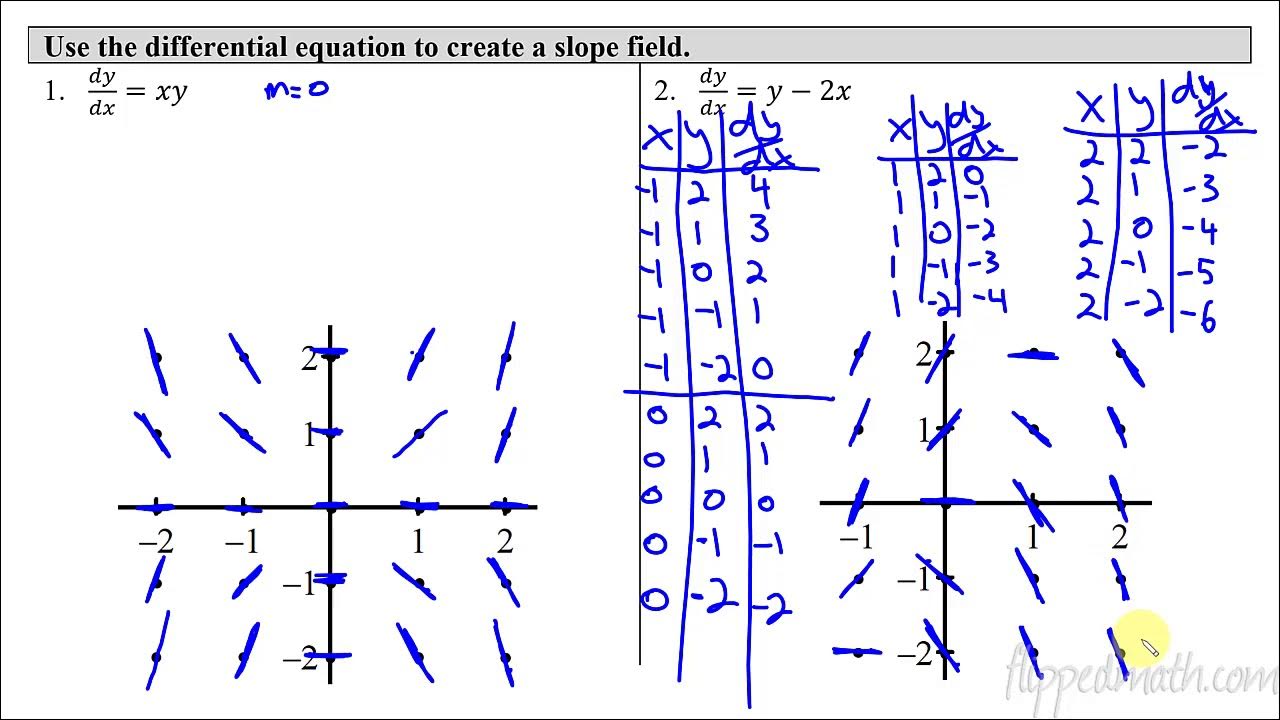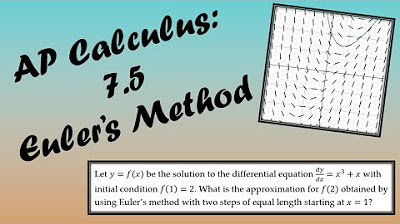Slope field to visualize solutions | First order differential equations | Khan Academy
TLDRThe video script discusses the concept of a slope field for a given differential equation, specifically dy/dx = y/(6*4 - y). It explains how the slope field can be verified by calculating the derivative at various points and comparing it to the depicted slopes. The script further illustrates how the slope field can be used to visualize potential solutions, highlighting that while the exact form of the solution is not known, the field provides insights into the nature of the functions that could satisfy the differential equation. It also identifies specific solutions such as y = 0 and y = 4, where the derivative is zero.
Takeaways
- 📚 The script discusses a differential equation and its corresponding slope field.
- 🔍 The slope field is verified by calculating the derivative at specific points (x, y).
- 📈 The slope of the field is dependent on the y-value, not the x-value.
- 🤔 The script uses the slope field to visualize potential solutions to the differential equation.
- 🌟 The slope field can help in understanding the behavior of solutions without explicitly solving the equation.
- 📍 Points with a y-value of 4 or 0 are explicitly solutions to the differential equation.
- 🚫 The script highlights that the slope field does not provide the exact solutions but gives an approximation.
- 🧠 The process of using the slope field helps in getting a conceptual understanding of the solutions.
- 📊 The script demonstrates that solutions with y-values between 0 and 4 exhibit certain characteristics.
- 🔄 The script encourages further verification of points on the slope field for a better understanding.
- 🎯 The slope field is a tool for visualizing the dynamics of solutions to first-order differential equations.
Q & A
What is the given differential equation in the script?
-The given differential equation is dy/dx = y / (6 * (4 - y)).
What is a slope field in the context of differential equations?
-A slope field is a graphical representation that shows the slopes of the solutions of a differential equation at various points in the xy-plane.
How does the slope field verify the differential equation for the point (1,1)?
-At the point (1,1), the slope field shows a slope of 1/2, which is calculated by substituting x=1 and y=1 into the differential equation, resulting in (1/6) * (4 - 1) = 1/2.
Why is the slope of the solution independent of x when y is one?
-The slope is independent of x when y is one because the derivative in the differential equation is only dependent on y, not x, as long as y remains constant.
What is the slope at the point (1,6) according to the differential equation?
-At the point (1,6), the slope is -2, calculated by substituting x=1 and y=6 into the differential equation, resulting in 6/6 * (4 - 6) = -2.
What is a solution to the differential equation?
-A solution to the differential equation is a function y(x) that satisfies the differential equation for all values of x in its domain.
How can the slope field help visualize solutions to the differential equation?
-The slope field helps visualize solutions by showing the slopes at various points, which gives an idea of the direction and steepness of the solution curves as they pass through those points.
What are the horizontal lines in the slope field, and what do they represent?
-The horizontal lines in the slope field represent points where the slope is zero, indicating that the solution curves are horizontal at those y-values.
What are the y-values for which the solution curves are horizontal lines in the slope field?
-The solution curves are horizontal lines when y is equal to 0 or 4, as these are the points where the derivative is zero according to the differential equation.
How does the slope field suggest the shape of solutions for y-values between 0 and 4?
-For y-values between 0 and 4, the slope field suggests that the solutions will initially have a positive slope, then become more horizontal as y approaches 4, and finally decrease to a slope of zero as y reaches 4.
What is the significance of verifying points on the slope field?
-Verifying points on the slope field helps ensure that the graphical representation is consistent with the differential equation, providing confidence in the accuracy and usefulness of the slope field for visualizing solutions.
Outlines
📈 Introduction to the Differential Equation and Slope Field
This paragraph introduces the differential equation dy/dx = y/(6 * (4 - y)) and explains the concept of a slope field. The voiceover describes how to verify the slope field by selecting points (x, y) and calculating the derivative based on the equation. It demonstrates this with the point (1, 1), showing that the slope is 1/2 when y is 1, and explains that the slope is dependent on y, not x. The paragraph also discusses how the slope changes as y varies, and how this can be visualized using the slope field. The goal is to use the slope field to get a sense of the solutions to the differential equation.
🌐 Exploring Solutions and the Role of the Slope Field
The second paragraph delves into the exploration of potential solutions to the differential equation using the slope field. It establishes that y = 4 is a solution to the equation, as the right-hand side of the equation becomes zero when y is four, resulting in a derivative of zero. Similarly, y = 0 is also a solution. The paragraph then discusses how the slope field can guide us in visualizing the shape of solutions that pass through various points, such as (0, -1.5) or (0, 0.5). The voiceover emphasizes the usefulness of the slope field in gaining a conceptual understanding of the solutions to the differential equation, especially when the equation involves only the first derivative and variables y and x.
Mindmap
Keywords
💡differential equation
💡slope field
💡derivative
💡solution
💡y-value
💡x-value
💡visualize
💡slope
💡verify
💡approximation
💡conceptual understanding
Highlights
The differential equation is given by the derivative of y with respect to x, equal to y over six times four minus y.
A slope field is plotted for the given differential equation to visualize the slopes at various points.
Verification of the slope field is done by selecting a point (x=1, y=1) and calculating the slope from the differential equation, which matches the slope field.
The slope is found to be dependent only on the y-value, regardless of the x-value.
For y=1, the slope is consistently 1/2 across different x-values.
The slope field is used to visualize potential solutions to the differential equation.
A solution passing through a point (x=1, y=6) results in a slope of -2.
The slope field confirms that y=4 is a solution to the differential equation, as the derivative is zero when y equals four.
Similarly, y=0 is also a solution to the differential equation.
The slope field suggests interesting behavior for solutions that include points where the y value is between zero and four.
Solutions with y-values exactly at zero or four result in horizontal lines.
The slope field can guide us in sketching potential solutions based on the slopes at different y-values.
The method of using a slope field provides a visual and conceptual understanding of the solutions to a differential equation.
Slope fields are particularly useful for first derivative differential equations involving x's and y's.
The process of solving for the slopes and plotting them allows us to get an idea of what the solutions might look like.
The slope field helps in identifying the class of functions that might satisfy the differential equation.
By examining the slope field, one can infer the general shape of solutions that pass through specific points.
Transcripts
Browse More Related Video
5.0 / 5 (0 votes)
Thanks for rating:





